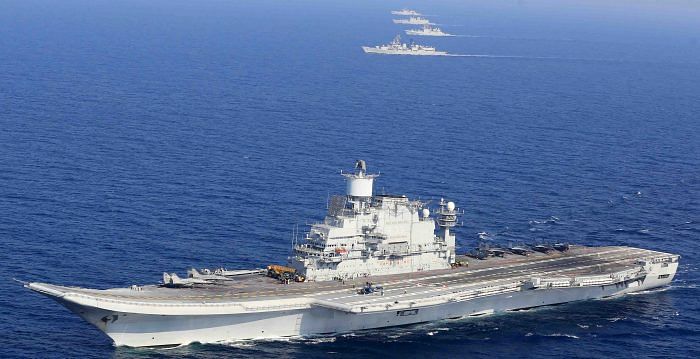New Delhi: The Indian Navy is firm on its plans to have a third aircraft carrier despite Chief of Defence Staff (CDS) Gen Bipin Rawat’s scepticism, and will approach the government for permission to initiate formal design consultancy, ThePrint has learnt.
“The third aircraft carrier is an operational necessity,” a source in the Navy said. “It is not that an aircraft carrier can be bought off the shelf. Even if all permissions are given today, it will take 15 years for the carrier to be inducted.”
A second source said the Navy was moving ahead with the design consultancy phase for the carrier, adding that formal permissions would be sought.
The Indian Navy currently operates one aircraft carrier, INS Vikramaditya, while the second, INS Vikrant, is under construction in Cochin, due for commissioning in 2022. Both vessels have a displacement — the measure of a vessel’s weight — of 45,000 tonnes each.
While the Navy has had its eyes set on a third aircraft carrier, General Rawat, who oversees all three military branches in his role as CDS, said earlier this month that it was not a priority. Preference, according to him, would be given to submarines and air-strips on the far-flung Indian islands in the Andamans.
Also Read: Navy’s Tejas aims for first-ever take-off from aircraft carrier Vikramaditya
Third aircraft carrier part of long-term capability planning
Dismissing any budgetary concerns, sources said every force is driven by long-term capability planning that also takes into account budgeting requirements.
Asked if the Navy had budgeted for both submarines and the third carrier, a source said, “The submarines, both nuclear and conventional, are important. The third carrier is a project for the future but work has to begin now. The work that needs to be completed first is the design element. Budget is catered for.”
Navy chief Admiral Karambir Singh had said in December last year that the force’s long-term capability planning envisaged the induction of three aircraft carriers so that two are available for deployment in the Indian Ocean Region, where China has been making inroads, at all times.
A project study initiated during the tenure of former defence minister Manohar Parrikar decided that the third carrier would be a 65,000 CATOBAR (Catapult Assisted Take Off but Arrested Recovery) system with electric propulsion.
‘Shore-based air ops not enough’
Navy sources said shore-based air operations, as preferred by the CDS, were still limited by range, and this is where the aircraft carriers came into play.
They added that External Affairs Minister S. Jaishankar had defined the Indian Ocean Region (IOR) as including countries fringing the entire Indian Ocean, from the Strait of Hormuz to Reunion island, from East Africa to Australia, and from Lombok Strait to Malacca Strait.
This vast oceanic expanse, they said, was well beyond the capability of strike aircraft operating from the Indian mainland, which would barely cover even 20 per cent of this area and thus leave vast swathes of IOR unchallenged.
In addition, fighter jets operating in the sea would need a significant amount of time to manoeuvre, especially if challenged by enemy fighters. This limits their range too, they said.
The sources highlighted that shore-based strike aircraft from any service, be it the Navy or the Air Force, would be in a defending position at best within 1,000 km of the coast.
Also Read: From INS Vikrant to INS Imphal, how names of Indian Navy ships have evolved over the years
‘Must have two aircraft carriers operational at all times’
The sources reiterated Admiral Singh’s concerns, saying it was important to have a third carrier because it would ensure two are always ready for deployment, even when one is in for refits.
“The Vikramaditya will also age over the next two decades. Moreover, the Navy’s project for 57 fighters along with the the twin-engine Tejas, as well as the currently-used MiG-29K, caters to… three carriers,” one of the aforementioned sources said.
The sources added that the country had to decide whether it planned to “play a bigger game” in the global maritime structure.
They pointed out how the People’s Liberation Army (PLA) Navy of China, which has been making repeated forays into the Indian Ocean Region, plans to become a four-aircraft-carrier force by the end of the decade.
By 2049, they added, China was looking to have 10 aircraft carriers.
Aircraft carriers ‘back in reckoning’
The sources sought to note how countries like the UK, which had developed doubts about aircraft carriers, had once again woken up to their potential.
The US, one of them said, “of course continues to repose their faith in aircraft carriers”.
While Russia, Italy and France operate aircraft carriers, the sources added, Japan was in the process of converting all its helicopter carriers into aircraft carriers. Australia, they said, had helicopter carriers that are equipped to operate fighter aircraft in a jiffy.
Also Read: Boeing plans trials of its Super Hornet jets on ski-jump ramp to meet Indian requirements
